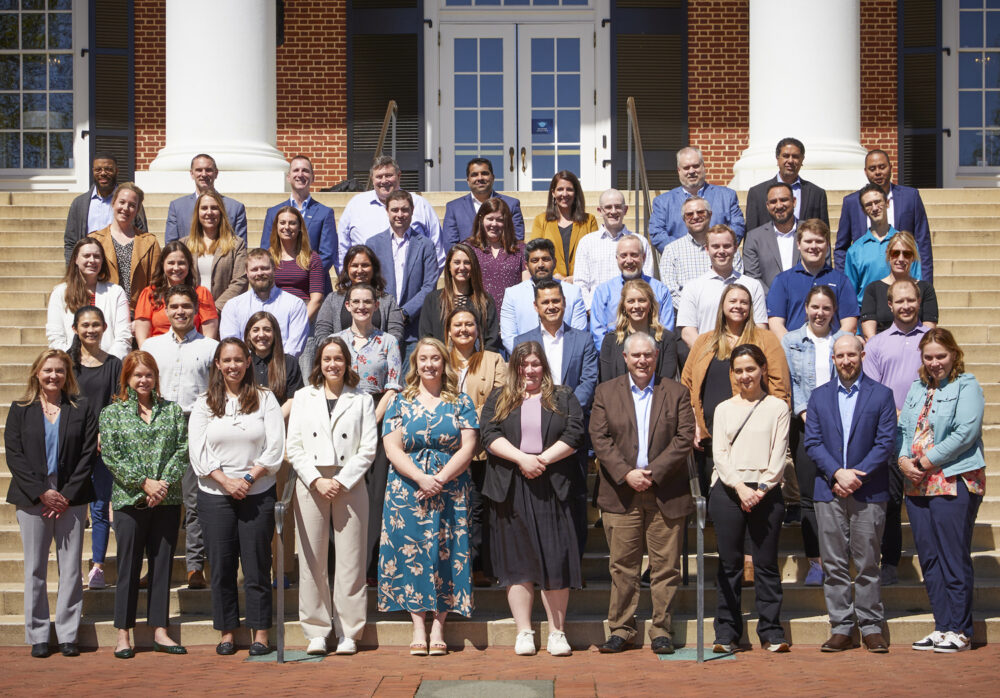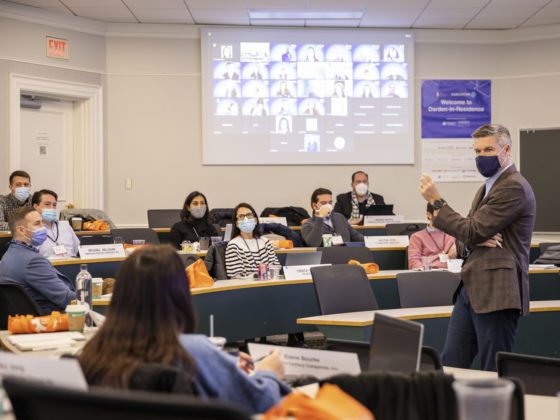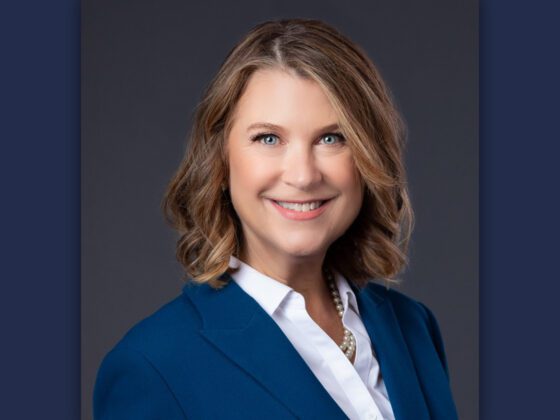In 2022, UVA Darden Executive Education & Lifelong Learning partnered with U.S. manufacturer Kohler Co. to design and deliver a customized training program. The Kohler Capability Accelerator (KCA) integrated three distinct courses, each geared
towards upskilling functional managers in marketing, supply chain management and data analytics. Kohler came to Darden with these learning objectives clearly articulated, and a specific mandate: to design an online learning journey in order to scale impact across a geographically dispersed workforce. And to do it fast.
When Kohler chose Darden to be its learning partner, they did so on the basis of our expertise in digital and blended executive programs for organizations — an expertise built over more than a decade of designing curricula that pinpoint organizations’ needs and developing technology powered pedagogy to keep learners motivated as they acquire new skills. They also chose us for the quality of our globally renowned faculty.
And they chose us because they knew we had what it takes to build a world-class customized program at speed. In all, from first consultation to the program inception, KCA took just two months to build.
Anne Trumbore is the Chief Digital Learning Officer for The Sands Institute for Lifelong Learning at UVA Darden. Here she shares insights into how the Darden team made KCA work, how we created the program for them at warp speed, and the three things that any organization and Executive Education team need to do to guarantee success.
How did you kickstart the process of designing a program for Kohler?
The first thing we did was sit down with Kohler’s Learning and Development leads to review their objectives. When they came to us they had three areas of capability that they wanted to develop. From here we needed to work with them to co-design clear learning objectives and the metrics we wanted to track. So we worked with Darden faculty to translate their goals into subject matter knowledge that would form the basis of their curriculum. This work was then returned to Kohler and socialized with their heads of marketing, data analytics and supply chain. This is a critical first step: if you want to create an effective learning solution, you have to really co-design the learning objectives and ensure everyone is on the same page.
Kohler wanted a digital program and they wanted it delivered fast. How were you able to create KCA in two months?
With Kohler, we weren’t going to be in a position to create a custom program with new content from scratch because of the exigencies of their timeframe. We were able to expedite the design of the curriculum by leveraging Darden content — our rich in-house portfolio of programs and faculty expertise — and then work with our professors to customize these assets so that they pinpointed Kohler’s needs.
Again, once we had a curriculum, we sat down with the Kohler team and worked together on the iterative process through to completion.
Once we had the curriculum down, we worked with Kohler to co-create their assessment protocol. One of the key differences between online programs and face-to-face learning is the measurability that the digital environment affords you; there’s actually far more data that you can capture to track the learner’s progress and understanding. This can make online a much richer learning solution for organizations. It’s a benefit beyond the scalability that digital programs offer.
What did Kohler want to assess and why?
Any organization designing a learning program will want to see its people complete the journey, and this was built into KCA as a participant obligation. To keep the learning momentum forward moving, we designed assessment elements in each module, and we integrated one-on-one time with learning coaches to help participants overcome challenges and keep them motivated and progressing towards the finish line.
But as we talked with Kohler about assessment, what became clear was that the principal metric of the program should be how well participants could apply their learning to current, real-life business problems. They wanted to see the program’s impact in action in the work environment; to measure the extent to which their functional managers had come along in terms of their technical skills and decision-making.
So we co-designed a project for participants that they would lead with input from their managers at the end of their learning journey. And for Kohler this was a significant pay-off and real return on investment. They could see a clear enhancement in capabilities across three critical functional areas of their organization, and they could see it in action.
The big pay-off for Kohler was the project we codesigned where participants put new skills and knowledge to work in the real world environment.
How did you go about co-designing this assessment project with Kohler?
It was critical that projects addressed real-world business problems and that Kohler learners had the wherewithal and the autonomy to decide what those problems would be. So we worked with their team to build a framework for learners to use, and their principal assignment on finishing the first of their three modules was to identify the focus for their project and take it back to their managers for discussion.
At the end of the program, project work got underway with participants and their managers leveraging the learning and the Darden framework to help them pinpoint objectives and build a roadmap for execution.
As their learning partner, we were looped into the progress and success of this project work via feedback mechanisms such as surveys.
Capturing feedback was critical at every inflection point of the program, from beginning to end.
Why was participant feedback so key and what did you do with it?
Getting learner feedback is essential because it gives you the ability to monitor their progress—and also to adapt elements of the content or the program experience to overcome obstacles and accelerate learning. With KCA, we integrated mechanisms such as discussion boards and surveys, and looking at the input from participants we were able to add more live, interactive sessions with Darden professors to address specific needs.
Capturing feedback on the go is really critical if you want to modify and improve a learning experience just in time. It’s also a tremendous opportunity to truly customize a program to the needs of the learner in real time.
At the end of the day, we were able to provide a really rich, robust and highly customized learning experience with direct applicability to custom business problems for a globally-dispersed workforce. And we did this at speed, at scale and at a price-point that made the solution highly accessible for our client.
With KCA, we integrated agile feedback touchpoints to be able to iterate on the fly, and provide even more customization of the program around real-time learner needs.
Darden’s work with Kohler is set to continue on with future cohorts lining up to go through KCA. What are the secrets of your success in designing this — and any executive program — for an organization looking to upskill its workforce?
Something that’s often overlooked are the affordances that technology provides. Digital learning can create experiences that are as immersive, if not more so, than on-campus programs. You have to be able to look at the platform and figure out how to drive it. There’s a misconception about online learning that it’s just like driving one car, but in reality you can build and drive everything from a mini-van to a Ferrari. If you’re going up a curvy road in ice, you need a four-wheel drive. So having an understanding of what the technology can really offer you is key.
Another element is having a clear understanding of learner needs. You must have a clear picture of what they need and the ability to revise your solution to meet those needs on the hoof.
With online programs in particular, you are disaggregating time and space — you obscure the feedback loop between professor and learner in the classroom. So you need to be able to use the technology to capture feedback and revise. And, by the way, revision isn’t a sign that the program is no good. Revision is a sign that you are making the program work for the learner. Online programs should be active events, so you need a team that is constantly monitoring the data and interacting with the client. This is not a library, it is an active event. A program should be a concert.
Finally, on the human level, you really need to build the relationship and the communication between the learning solution provider and the organization. And it’s incumbent on the organization to incentivize learning in their workforce. Learning needs to be contextualized as a path to advancement within the business. And leaders can ensure this happens by giving their employees the time they need to invest in the program, and the recognition when they successfully complete.




